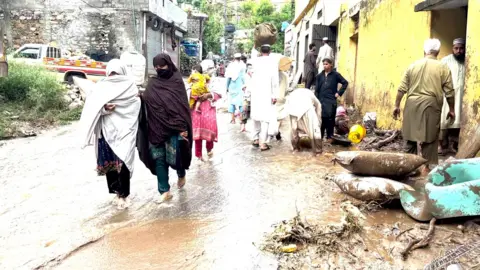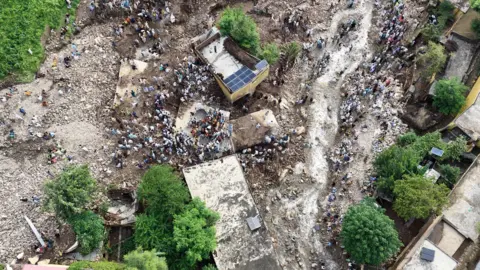Pakistan correspondent
 BBC
BBCAs villagers carried out the bodies of two children, soaked in mud, the large crowd looked impassive.
They had gathered in a small village in the Swabi district of Khyber Pakhtunkhwa after a flash flood washed away several houses, trapping dozens underneath the rubble.
Some of them watched on as the dead children were taken away, others continued their conversations, and the rest – along with a few rescue personnel and soldiers – kept searching for survivors with their tools and bare hands.
There were no tears, there was no panic. But there was anger.
For many villagers it was the fact that the floods came with no warning.
“Why didn’t the government warn us sooner?” was the overwhelming sentiment.
But there was also rage at a perceived lack of support from local officials.
“We need the right equipment to carry out this rescue,” Arif Khan, who was helping dig out the bodies, told us.
“There were about 15 houses here, we need an excavator.”
Although emergency teams and the military were there to help, the equipment Arif had been begging for was trapped a few hundred metres away, unable to get through a flooded road.
“The ambulances, medicines and excavators are very much on the way,” Nisar Ahmad, the commissioner for the Mardan District, told us. But they were still not able to reach the village due to the scale of the flooding. Throughout the day, the villagers continued removing the debris, as well as the bodies.
Scenes like this are not new in Pakistan. Since June alone, monsoon rains have killed about 800 people across the country.
In 2022, monsoon rains killed about 1,700 people, which cost Pakistan $14.9bn (£11.1bn) in damages and $16.3bn in recovery and reconstruction needs, according to the World Bank.
And in June this year alone, monsoon rains have killed at least 750 people across the country.
So if history is repeating itself, why can’t Pakistan better protect itself from the onslaught of floods?

Paying a big price for ‘international sins’
Pakistan’s geography makes it extremely vulnerable to climate change – with the country having to contend with not just heavy monsoon rains, but extreme temperatures and drought. Its melting glaciers have also created new lakes at risk of glacial outbursts.
These trends are getting worse because of climate change, according to Dr Syed Faisal Saeed, chief meteorologist at the Pakistan Meteorological Department (PMD).
“Monsoon rains are likely to increase in the coming decades, so this issue is not a one year fix,” he says.
Yet, this is a bitter pill to swallow for many, given Pakistan contributes less than 1% of the global greenhouse gas emissions.
There is a feeling that it is paying a big price for “international sins”, says Dr Amjad Ali Khan, a member of Khyber Pakhtunkhwa’s National Assembly, who advises the chief minister on climate issues. His province is where most deaths have been recorded during this year’s monsoons.
This is a sentiment shared across the political spectrum. The former federal climate minister, Senator Sherry Rehman, recently argued “when lives are lost in the Global South, when rivers burst their banks, and when livelihoods vanish, there is no real money for climate-vulnerable countries like Pakistan”.
Some argue the country wrestles with how to spend its own money.
Climate resiliency will likely always contend with other priorities – such as defence – as this year’s federal budget has shown.
Amid an overall reduction in spending, the budget for the Ministry of Climate Change was slashed to about $9.7m (£7.6m). Defence spending was hiked up to about $9bn (£6.93bn).
Ms Rehman slammed the cuts, and argued they send the wrong message. When the budget was announced, she asked: “If we are not seen investing in our own resilience, why would others support us?”

The Ministry of Climate Change’s budget doesn’t reflect climate funding in Pakistan, argues Ali Tauqeer Sheikh, an expert in climate risk management.
Under its agreement with the IMF, the federal government also earmarked more than $2bn more in climate-related spending. Yet, Mr Sheikh says it includes some existing projects, such as dams and hydropower.
He says the budget aside, there are more than 1,000 unfinished development projects across sectors.
With no short-term fix to the impacts of climate change, early warning of these extreme weather events is a priority for the Pakistan Meteorological Department (PMD).
Extreme weather events such as cloudbursts are hard to predict in advance. They’re caused by a sudden updraft in humid, moist air, which leads to a heavy and localised burst of rain. These have wrecked villages in recent days.
But Dr Saeed has said while these can’t be predicted days in advance, the general conditions that can lead to a cloudburst can be identified.
“When the PMD warns of heavy rainfall, all the districts should start preparing,” says Dr Saeed, though he does acknowledge that the PMD needs to improve its system.
“I’m not saying it’s perfect.”
As part of an initiative with the World Bank, the PMD is procuring new radars and automatic weather stations, as well as working to improve its short-term modelling.
A bigger challenge is getting the word out. Some of the worst episodes this summer happened in rural, mountainous regions, where network connectivity is very poor. A weather app or social media accounts won’t do these communities much good.
PMD is trialling new methods to get around this, alongside the United Nations Development Programme.
From the capital Islamabad, the PMD can trigger sirens installed in glacial valleys in northern Pakistan that are vulnerable to extreme flooding from glacial lake outbursts. But officials acknowledge this is not a silver bullet, as the damage this year has shown.
Laws that go ignored
Part of the reason is that the most vulnerable communities live by riverbeds. While several laws such as the “River Protection Act” – which prohibits construction within 200 ft (61m) of a river or its tributaries – have been passed, people not only haven’t moved, they’ve also continued building in these areas.
“You would be erasing villages,” says Dr Khan, adding that people have been living along these rivers for decades and the law is impossible to implement.
Dr Khan argues lawmakers did not consider the culture of these communities which revolve around tribal elders, and that jirgas – tribal councils – should have been consulted to convince people to move.
He also argues it’s “next to impossible” if alternative housing and shelters aren’t funded and built for these communities.
Building laws are violated in urban areas as well. Pakistan’s commercial capital Karachi was recently paralysed by flooding, with officials forced to declare a public holiday to deal with the aftermath.
So far, about 30% of deaths from this year’s monsoon season are from houses collapsing, according to the country’s National Disaster Management Authority (NDMA).
“Nobody follows the laws. Every street is becoming congested,” Dr Yasmeen Lari, an expert in climate-resilient architecture, said.
Karachi is also a victim of its poor drainage system.
Though the city has hundreds of them, they have either narrowed or been blocked by illegal construction.
The housing minister of Sindh province, of which Karachi is the capital, says finding space to create new ones has been a challenge, and when they’ve tried to remove shops or buildings that cover them, their attempts have been blocked in court.
Saeed Ghani added that a new, more punitive law was in consultation to close legal loopholes, as well as hold officers of the Sindh Building Control Authority liable, should they approve construction that violates regulations.

Natural disasters amid political upheaval
If this reveals the cost of fragmented governance, there have been efforts at the federal level to try to secure more help from the international community.
Pakistan’s struggling economy has relied on several international bailouts. Successive governments have made it a priority to seek international support for its climate programmes.
They have secured funding from the World Bank and the United Nations, in addition to loans from the International Monetary Fund over the years.
A landmark moment was at the COP27 climate summit. The 2022 floods were fresh in the minds of the attendees, and the devastation had affected 33 million people. Pakistan and others pushed to establish the Loss and Damage Fund to help countries hit by climate disasters.
Domestically, there have been afforestation plans to restore natural flood barriers. In 2023, the government launched a “National Adaptation Plan” aiming to create a nationwide roadmap.
But it remains to be seen how this will all develop in practice, in a country which has seen so much political upheaval and changes in government.
At the end of most conversations, whether with officials, climate experts, or the frontline victims of these extreme weather events, there is a certain hopelessness. “Poverty is the worst thing,” Dr Lari says.
Without enough money, whether from the international community, the federal government or provincial budget, it is hard to execute the solutions they’ve all preached.
A better early warning system, new homes on safer land, climate-resilient infrastructure – all these take funding and any progress so far hasn’t prevented the hundreds of people killed this year.
“Everything is top-down,” Dr Lari explains. She says there has been too much reliance on governments, without enough results. If Pakistan does not have the means to fund these solutions, she argues, it should focus on educating the population and creating a “poverty escape ladder” at the grassroots level.
She points to her work in thousands of villages, sharing knowledge of climate-resilient homes, food security and tree planting.
In the meantime, this year’s monsoon season is not over – and neither is the sense of loss and grief.
Back in the village in Swabi district, a funeral was taking place for those found, only a few metres away from a rescue operation.
Prayers were chanted in unison, as the country prepared for warnings of more heavy rains, and more danger they are struggling to protect against.
Prompt
Source link
#deadly #floods #devastating #Pakistan

